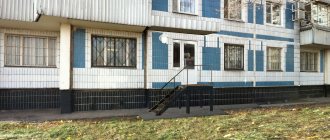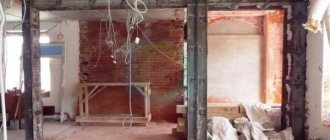In what cases is demolition approval required?
Information about the layout and other parameters of each apartment is stored in the unified register of the Unified State Register and the BTI database. The layout is reflected in the technical passport:
- all load-bearing walls, partitions;
- configuration of the bathroom and communications;
- door and window openings.
If the planned work changes the configuration of the apartment so that it is necessary to make changes to the technical passport, approval will be required. For example, the demolition of a non-load-bearing partition will lead to combining rooms and changing the layout of the apartment. Approval is issued by the authorized architectural unit (AP) of the local municipality. The appropriate permission in writing is a sufficient basis for carrying out work and changing the relevant entries in the Rosreestr database.
For your information! It should be emphasized that significant changes in consumer parameters of housing require the consent of all owners.
Without detailed clarification, it is possible to draw the correct conclusion based on changes in the technical passport. If after reconstruction no correction of this document is required, there is no need to coordinate repair operations. Example: replacing failed wooden frames with new plastic window blocks in a main wall. However, the expansion of the doorway in a light partition by several centimeters should be fixed according to the scheme discussed above.
Redevelopment of load-bearing walls
In case of some violations during the repair process, the load-bearing frame of the building is damaged. This threatens the health and life of not only the apartment owner, but also his neighbors. To ensure safety, such structural changes are carried out exclusively according to a special project. It is developed by specialized institutions with mandatory calculations of the load-bearing capacity of structures.
To avoid difficulties in disposing of the property in the future, it is recommended to coordinate the demolition or other actions with non-load-bearing walls.
Listed below are some of the current prohibitions when remodeling an apartment:
- combining the kitchen with a common room and other rooms;
- dismantling of load-bearing structures without an agreed strengthening project;
- excessive increase in kitchen space at the expense of the living area;
- moving and other actions with utilities for general house purposes;
- expansion of the balcony due to the adjacent room;
- placement of sanitary facilities and kitchen areas above living quarters;
- creating obstacles for other residents to use passages and other common property in an apartment building.
As can be seen from the list, in order to move the wall without errors, the strength parameters and current restrictions must be taken into account in a complex. Thus, creating a doorway from the toilet directly into the living room is prohibited. However, an exception is made for disabled people.
What you should know when remodeling an apartment
Before renovating an apartment, it is important to familiarize yourself with a number of rules that limit the transfer or demolition of partitions. So, the kitchen should not become part of the living space. This part of the apartment cannot be combined with living space. Hot and cold water risers are also not allowed to be moved. Before thinking about redevelopment, you should take into account that the apartment should not have rooms smaller than 8 square meters without natural light.
If the owner wants to move the bathroom, it should be taken into account that its new location should not be above the kitchen or living space of the neighbors below. The bathroom can only be expanded by:
- pantry;
- corridor;
- hallway
If it is necessary to demolish a load-bearing concrete wall, a dismantling method must be selected. Everything will depend on whether further major renovations are planned for the apartment. For example, a jackhammer contributes to the formation of a large amount of dust, which will be almost impossible to get rid of without subsequent repairs.
Demolition of monolithic walls in domestic conditions is often carried out using a grinder with a diamond wheel. In this case, pieces of walls must be cut out in stages. It is necessary to move forward, starting from the ceiling, making sure that the monolith does not fall to the floor in large pieces, as this may cause a violation of the integrity of the ceiling.
The redevelopment rules state: working with ventilation ducts without obtaining special permits is prohibited. It is impossible to carry out actions to dismantle or reduce boxes. It is impossible to move the entrance to the bathroom so that it comes from the kitchen and living room.
List of required documents
For an initial application to BTI or another design institution, you need to prepare:
- civil passport (equivalent identity card);
- application in any form to receive a project;
- title documents for the apartment.
As a result, a redevelopment project will be issued here.
Before visiting the architectural department of the local administration, preliminary preparation is required. The list below is adjusted to reflect actual conditions:
- application according to the approved sample - ;
- written consent for redevelopment from other owners (adult family members);
- DCT, social tenancy agreement or document confirming ownership;
- technical report along with documentation confirming the possibility of moving the walls;
- consent of the management company;
- confirmation of the absence of debts on utility and other regular operating payments;
- certificate of residents registered at this address;
- agreement with the mortgagee.
Depending on the scope of the work, it may additionally be necessary to coordinate the demolition of a wall in the apartment with other residents of the house and the following organizations:
- Ministry of Emergency Situations;
- SES;
- gas services;
- Rospotrebnadzor.
For your information! When submitting documents with the help of a proxy, it is necessary to properly execute the order with notarization of authority.
Registration cost
In cases where the property owner wants to carry out a large-scale overhaul, as a result of which the parameters of the home will change, it will be necessary to go through complex approvals.
Costs for documenting major repairs:
| Documentation | Minimum price, thousand rubles | ||
| To coordinate redevelopment | without carrying out work on supporting structures | 40 | |
| with arrangement of an opening in the load-bearing partition | 60 | ||
| with the demolition of the window sill (the façade is glazed) | 60 | ||
| in MNIITEP houses | 60 | ||
| Coordination of different options | |||
| association of apartments | 90 — 140 | ||
| fireplace arrangement | 240 | ||
| Registration of an acceptance certificate for completed repair and construction work | 20 | ||
| Technical plan drawn up by a cadastral engineer | 12 | ||
| Replacing an old certificate of title with a new one | 35 | ||
| Technical report on the possibility of carrying out work and the condition of the structure of the structure | 15 | ||
| Technical report on the safety and legality of the repair and construction work performed | 15 | ||
| Project | redevelopment of 1 apartment | 12 | |
| connections of 2 apartments | 30 | ||
| flooring | 8 | ||
| fireplace arrangement | 35 | ||
| arrangement of an opening in the ceiling | 30 | ||
| stairs | 40 | ||
| Order a passport from the Bureau of Technical Inventory | 3 | ||
It is best to carry out redevelopment in a monolithic structure during the construction phase.
This will avoid additional financial and time expenses.
- Any global changes, for example, when converting a two-room apartment into a three-room apartment, will require the development of a project.
- Minor transformations in which the load-bearing structures are not affected can be agreed upon according to the sketch.
Procedure
The following algorithm is used to demolish walls in an apartment without violating current legislation:
- To make significant design changes, the owner contacts the design agency to prepare a high-quality package of documentation.
- The destruction of non-load-bearing walls and other simple operations can be depicted on the existing plan independently.
- Collect the necessary certificates and confirmations.
- The technical passport received from the BTI and the accompanying documents according to the list are applied to the architectural department of the municipality.
- Obtain official permission to redevelop the apartment (approval for the demolition of a wall).
- Perform work operations.
- They invite a BTI specialist to professionally record the changes made in the work completion certificate (transferred to the register without the participation of the property owner).
- Based on the measurements taken, BTI creates a new technical plan.
- This document is submitted to Rosreestr through the MFC in order to make adjustments to the entries in the database.
How to determine load-bearing walls in a monolithic house
Monolithic walls can be dismantled only after determining that the structure is load-bearing. If this is the case, you cannot remove it yourself without the appropriate permits, because this could cause the building to collapse. Such unpleasant consequences result from the fact that the load on the floor increases, because previously it was partially borne by the load-bearing wall.
Redevelopment of an apartment in a monolithic building can only be done by dismantling the partitions. You can determine whether a structure is load-bearing by measuring its thickness. The minimum value for load-bearing walls is 140 mm. Partitions have a thickness of up to 100 mm. Interior load-bearing walls are reinforced concrete structures, the thickness of which varies from 140 to 200 mm. If the house belongs to the old series, the thickness of its load-bearing internal wall can be 120 mm.
Attention! It is necessary to determine the thickness of the wall in its pure form, excluding finishing decorative layers, for example, putty, plaster, tiles or wallpaper.
Approximate terms and cost of work
| Actions | Expenses | |
| Time, days | Money, rub. | |
| First contact with BTI | 10-14 | 500 – 1 500 |
| Creation of a package of project documentation | 14-60 | 2 500 – 35 000 |
| Additional permits (SES, Ministry of Emergency Situations, etc.) with the help of specialists | 15-30 | 5 000 – 20 000 |
| Coordination of the demolition of the wall with the local administration | 30-45 | – |
| Secondary application to the BTI, preparation of a technical passport | 10-14 | 1 200 – 4 500 |
| Registration of changes in the Unified State Register of Real Estate | 3-14 | 350 |
Preparatory work before demolition of walls
Preliminary work is carried out before demolition. All things and furniture are removed. The general heating system, water supply, electricity, gas, TV antenna and radio point should be turned off.
You also need to prepare bags for garbage disposal. If the volume of waste is large, then you should take care of the dumping site in advance. It is necessary to know the regulations for carrying out repair work in high-rise buildings. On weekdays this is from 9 am to 7 pm. On weekends, silence should be maintained, and you should not use devices or units that create vibration. If the volume of waste is large, then you should take care of the dumping site in advance.
FAQ
The recommendations collected in this section will help you coordinate the demolition of a wall in your apartment and correctly solve typical practical problems. If difficulties arise, study thematic information on the site. In the most difficult situations, turn to an experienced lawyer for help - advice can be obtained directly on our portal.
Redevelopment with a mortgage
In the list of standard conditions, banks set a limit on changes that significantly affect the value of the collateral. Unambiguous prohibitions are rarely used. To receive a positive answer, you will have to prove an improvement in consumer parameters (increase in value) after the demolition of the wall.
Correction of information in the USRN database is possible by agreement with the lender. It is recommended to complete the relevant documents in advance.
What are the dangers of uncoordinated redevelopment?
Illegal demolition of walls is punishable by a fine of up to 2.5 thousand rubles. If violations of current standards are detected, an increase of up to 5 thousand rubles is applied. rate. The composition and volume of violations have a significant impact on possible costs. In the most difficult situations, in addition to compensation for damage, the court has the right to use criminal penalties.
For your information! A one-time fine for a legal entity for such violations is up to 300 thousand rubles.
What to do if a crack appears in the wall
If such defects are detected, contact the management company. If a wall is cracked, authorized representatives of this organization must:
- perform an inspection;
- draw up an act;
- install control marks to check crack growth;
- eliminate causes that violate safety standards.
If the walls crack due to redevelopment done by a neighbor, file a claim with the court at the place of residence. To prove your case, you will need an expert opinion.
When a crack has formed as a result of a man-made accident, during the “natural” destruction of a dilapidated building, you should contact the local administration. A special commission of the municipality makes decisions on the demolition of a building or restoration work. Current legislation provides for measures to relocate residents and pay compensation.
If a wall in an apartment is cracked, you need to complain to the municipality. The effect of the appeal will come faster if you reinforce it:
- collective statement of several residents;
- results of an expert examination of the condition of the crack.
What to do if the wall has already been demolished
To formalize the work already completed, appropriate changes are made to the presented algorithm:
- They contact the BTI to organize a visit of a specialist and record the changes.
- They make a project with calculations (if the load-bearing walls in the apartment have been remodeled).
- Obtain opinions from the Ministry of Emergency Situations, SES, and other organizations (if necessary).
- They contact the administration, which refuses approval.
- With this refusal they apply to the district court at the place of residence, preparing a statement of claim for approval of the redevelopment.
- As a result of the investigation, approval for the demolition of the wall is obtained.
- Changes are registered in the Unified State Register of Real Estate.
The information presented in the publication explains where to go after a crack appears in the apartment. The relevant sections show an algorithm of actions for coordinating redevelopment (demolition of a wall) taking into account different initial conditions. Before applying the recommendations, you should clarify the current rules with the relevant authorities. Particular attention is paid to the preparation of accompanying documentation.
Use the site materials to clarify information on the topic. Contact the portal's duty lawyer for professional advice. Repost, like. Share your own experience in the comments.
Read further: illegal redevelopment of an apartment - consequences and responsibility.
Which non-load-bearing walls cannot be demolished?
There are several exceptions, due to which restrictions are imposed on the dismantling of partitions. So, you can’t demolish:
- the wall between the living room and the kitchen, if the latter is equipped with a gas stove;
- a wall separating the room and the bathroom;
- walls separating the loggia or balcony from the room or kitchen.
The State Housing Inspectorate does not approve such redevelopment. And if BTI employees discover unauthorized changes, the owner will pay a fine. Also, with a high probability, he may be required to return the apartment to its original condition.
Methods for demolishing walls
Let us dwell in detail on how to remove concrete. There are several ways to do this and you can choose whichever you like.
Sawing with a grinder
With a sufficiently powerful grinder and a supply of concrete discs, you can cut down the wall in pieces, removing one piece at a time. Decide for yourself in which direction you will start working. You can draw a cutting diagram directly on the wall.
There are two things worth saying about choosing an angle grinder. Firstly, it is desirable that it have as much power as possible. Secondly, it must support the ability to install large diameter disks. The width of the wall that you can eliminate depends on this parameter.
The advantages of this demolition method include low noise levels and minimal dust.
.
The disadvantages include the fact that the level of construction dust formation will still be considerable. After 5 minutes, visibility inside the room where work is taking place will sharply decrease. If you do not carefully close the rest of the rooms from dust, it will be everywhere: on all things and furniture, on the walls and ceiling. You will need glasses and a special mask to somehow breathe in such an environment. Be prepared for a thorough deep cleaning once the job is complete.
Powerful hammer drill
This is the easiest and fastest way
.
This is its main advantage, but the disadvantages include the maximum level of noise and dust formation
in comparison with other methods. In addition, in the hands of a non-professional, such a tool can cause more harm than good. If you aim poorly, you can break something unnecessary.
Impact drill or medium hammer drill
If you already have a fairly powerful impact drill or a regular hammer drill, you can carry out the redevelopment in the most comfortable way for yourself. The method is to use one of the above tools to drill holes in the wall. The easiest way to do this is along pre-drawn lines. The holes should be located next to each other.
When you have a kind of grid of holes, you can start knocking out pieces of concrete. To do this, take a hammer and chisel, or a sledgehammer if you don't want to make a lot of movements. With simple blows you will contribute to the formation of continuous gaps between the holes and soon you will be able to quite easily dismantle the entire wall.










